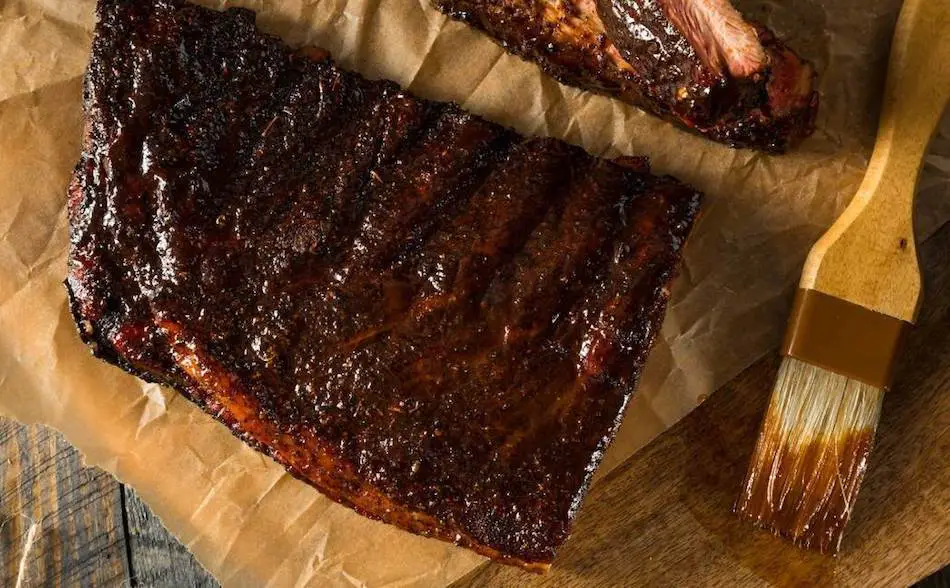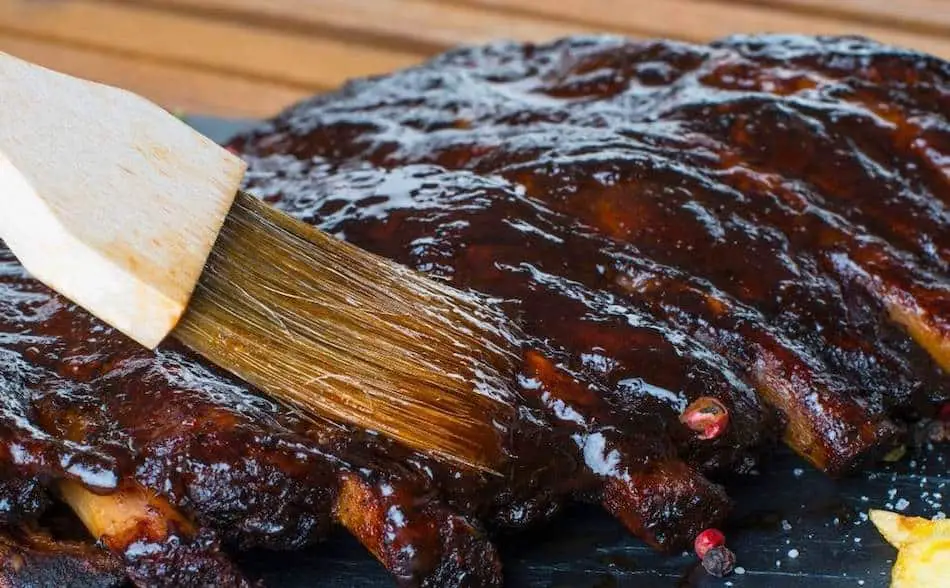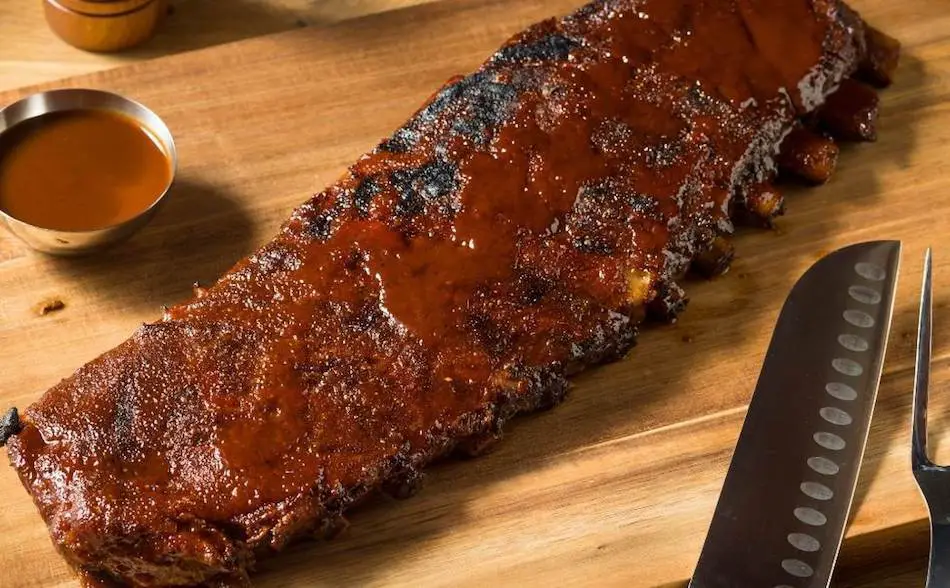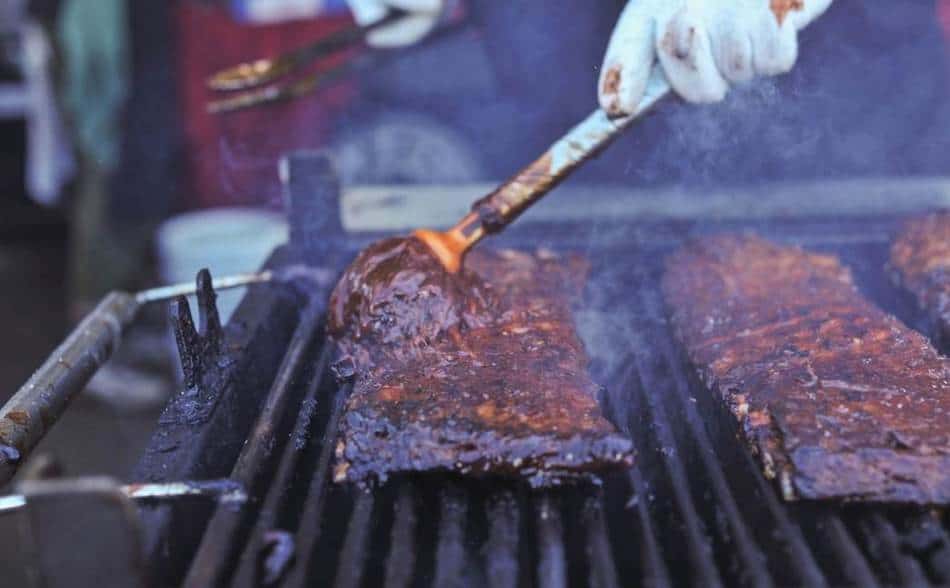
Saucing is the all-important last step in the rib smoking process. After spending hours in the smoker, the glaze adds the final layer of flavor to finish the ribs. However, as with most things in barbecue, timing is everything. I wanted to know how and when different barbecue gurus sauce their ribs. When it comes to saucing your smoked ribs, there are no hard and fast rules. Every pitmaster that I’ve seen do their ribs it a little different. In this article, I’ll walk you through all the best techniques for saucing your smoked ribs.
Saucing usually happens in the final stage of the cook (the last hour). If you’ve smoked ribs before, you would know they need to be cooked in different stages. During the first stage, ribs are cooked unwrapped. During the second stage, the ribs are cooked wrapped. In the final stage of the cook, the ribs are sauced.
Quick Tips
- Saucing is the final step in the rib smoking process, adding the final layer of flavor to finish the ribs.
- Timing is everything when it comes to saucing ribs, as it usually happens in the final stage of the cook (the last hour).
- Apply the sauce in the last 30 minutes to 1 hour to avoid burning the sauce and ruining the taste of the ribs.
- The most common way to sauce ribs is by using a basting brush, but some pitmasters may use a squirt bottle or spritz of apple cider vinegar.
- Building layers of flavor is key in smoking ribs, starting with smoke, then rub and seasoning, and finally the sauce.
- Popular methods for cooking ribs include the 3-2-1 method (3 hours unwrapped, 2 hours wrapped, and 1 hour in sauce) and the 2-2-1 method (2 hours unwrapped, 2 hours wrapped, and 1 hour with sauce), but experienced pitmasters may have their own methods.
| Technique | Pros | Cons |
|---|---|---|
| Basting brush | Allows for precise application and easy coverage of both sides of the ribs | Can damage the bark if not used carefully |
| Squirt bottle | Quick and easy, allows for precise application | Can be difficult to control the amount of sauce being applied |
| Applying during wrapping stage | Can add more flavor to the ribs as they cook | May not allow for proper glaze to be set on the ribs |
| Applying during unwrapped stage | Allows for proper glaze to be set on the ribs | May not add as much flavor to the ribs as they cook |
When To Add Sauce?
Ribs usually take 4 to 4 1/2 hours to cook. Apply the sauce in the last 30 minutes to 1 hour. If you apply the sauce any sooner, the barbecue sauce will burn and turn your ribs black and make them taste disgusting. Barbecue sauce contains a lot of sugar, and as you would know, sugar burns easily.

Set the Glaze
No matter which rib method you’re following, the sauce is always added at the end of the cook. Some methods will apply the sauce during the wrapping stage, while other recipes add the sauce during the unwrapped stage. No matter which method you use, it’s important to place the ribs back on the grill sauced and unwrapped at the very end so the glaze can set.

Don’t Burn The Sauce
Sugary sauces can burn easily and ruin your meat, so you need to be careful. Most barbecue sauces contain high amounts of sugar or honey, so be aware. So it’s important to monitor the ribs once they are covered in sauce. If you were to source the ribs in the beginning, by the end of the cook your ribs will be black.
How To Sauce Ribs
The most common way to sauce ribs is by using a basting brush. Squirt the sauce onto the ribs or place it into a bowl and then paint it on with a basting brush. Make sure you cover both sides. The problem with a basting brush is you can damage the bark. Be careful and use a soft basting brush. Take extra care when moving ribs around. Tongs can rip large chunks of bark from the ribs, so use a towel or heat-resistant gloves to handle the ribs.
Aaron Franklin will use a no-touch approach when applying sauce to his ribs. He squirts the ribs directly from barbecue sauce squirt bottle, then spritzes with apple cider vinegar to spread the sauce over the meat. Also, 15 minutes prior to adding the sauce, Aaron will spritz just to prepare the surface of the meat for the sauce to go on nicely.
Layers of flavor
As with all low-and-slow cooking, the skill is building layers of flavor. When smoking ribs, we’re building several layers of flavor. First, you get one layer of flavor from the smoke. Then you get another layer from the rub and seasoning. You also get another layer of flavor from the sauce.
A pitmaster will nurture a rack of ribs over many hours, building these layers of flavor. The bark gives the meat on the ribs texture as well as flavor. In the first stage of the cook, we want to develop that bark, so we get that crispy out of layer. The saucing is the final stage of the cook, where it’s just finishing it and adding that final coat of flavor. Timing is everything, and I don’t want to go too early with the sauce otherwise it’ll burn. You want to put it back on the heat just so it sets, and then you’ve got the perfectly smoked rib.

The 3-2-1 method is a popular method for cooking ribs. This method involves smoking the ribs for 3 hours unwrapped, 2 hours wrapped, and 1 hour in sauce. The 2-2-1 method is another common way to smoke ribs. This involves smoking the ribs for 2 hours unwrapped, 2 hours wrapped, and then 1 hour with sauce. Both these methods are popular on YouTube, but most experienced pitmasters don’t recommend cooking ribs this way. Food bloggers have popularized the 3-2-1, but barbecue gurus will tell you it overcooks the ribs. If you watch pitmasters like Aaron Franklin on Malcolm Reed, that don’t follow any set structure. They will go by look and feel.
Aaron Franklin will smoke his ribs at about 235° F for about 2 hours uncovered. Just 15 minutes before wrapping, he will spritz and then the 2-hour mark he will apply the barbecue sauce just before wrapping an aluminium foil. So Aaron Franklin does a little differently. He will smoke 2 hours uncovered, but he’s wrapping stage will be in sauce. He then continues cooking the ribs in the sauce wrapped for about another 2 hours. Franklin then applies some more sauce, takes the ribs out of the wrapping and places them back on the smoke after for about 15 minutes uncovered just to set the glaze.
The Best Sauces For Glaze
You can use just about any of your favorite barbecue sauce as the glaze for smoking ribs. Barbecue sauces such as Sweet Baby Rays are ideal, or whatever you use at home. You can use other try Asian sauces but barbecue is more traditional.
How Aaron Franklin Cooks Ribs
Barbecue master Aaron Franklin will cook his ribs at 275° F. He applies an olive oil as a binder, then we’ll use a simple salt and pepper rub which is traditional in the Texas area. This rub involves one part salt and two parts black pepper. Aaron uses a 16 mesh black pepper, and Morton’s kosher salt. Sometimes Aaron will also mix in a bit of paprika to give the ribs some color. You can also mix in some onion flakes and garlic powder just to give a savory flavor.
When Franklin trims the ribs, he removes the breastbone and squares them off. He applies a binder with olive oil and then his rub. For the first 2 hours, Franklin will leave his ribs on the smoker untouched. He then uses an offset smoker and sets it 275° F. As the cook approaching the 2 hour cook mark, Aaron will spritz the ribs with apple cider vinegar 15 minutes prior to adding the sauce and wrapping. Then at the 2-hour mark, he removes the ribs from the smoker and he applies the barbecue sauce by squirting it from the bottle.
Aaron uses a no-touch approach, because he doesn’t want to ruin the bark on the ribs. Aaron then takes a squirt bottle with the barbecue sauce from his restaurant, and squirts the ribs, and then spritzes it again to spread the barbecue sauce along the ribs. He then wraps the ribs into layers of aluminium foil and then places them back on the smoker for 2 hours.
Franklin removes the ribs after 2 hours and takes some out of the foil. Here plies one more layer of above his sauce then places them back on the smoker for 15 minutes unwrapped to set the glaze. Then he performs a tenderness test by twisting the bones, then looking and poking and bending the meat. He twists the bones a little, but has them so tender but not quite fall off the bone tender.
Best Ribs For Smoking
Spare ribs or baby back ribs are the best type of pork ribs for smoking. Then there are rib tips, riblets and country style ribs. It doesn’t really matter the principles are all the same. Treat beef ribs a little differently, and they rarely have a sauce. Pork goes well with sweet sauces, which is why we sauce the pork ribs.
My Favorite Meat Smoking Tools
Thanks for checking out this article. I hope you learned a few things. Here are some of my favorite tools I use when smoking brisket that may be useful to you. These are affiliate links, so if you decide to purchase any of these products, I’ll earn a commission. But in all honesty, these are the tools I recommend to my family and friends who are just starting out.
Meat Thermometer: There are dozens of fancy thermometers on the market, but I still use my trusty TP20. For around $50, I have a high-quality meat thermometer with two probes, and can track the temperature of my smoker with one probe, and my meat with the other probe. The ThermoPro TP20 is an Amazon Best Seller because it’s the easiest thermometer to operate, is durable, highly accurate, and comes with pre-programmed meat settings.
Instant Read Thermometer: Arguably, the second most important tool you need is a fast and accurate instant-read thermometer. These tools play an important role in the latter stages of the cook when the meat needs regular checking in multiple areas. I use the ThermoPro TP19 because it can do everything a ThermaPen can do, but for a fraction of the cost. You can check out the TP19 on Amazon here.
Wireless Thermometer: The latest thermometers on the market have no wires and can be controlled by wi-fi via your phone. Airprobe 3 is the best of this technology.
Butcher Paper: Wrapping brisket in butcher paper has become a huge trend in barbeque thanks to Aaron Franklin. Wrapping your brisket in paper will give you a nice brisket bark. However, you can’t just use any old paper, it has to be unwaxed, food grade paper. You can find it on Amazon here.
Advanced Thermometer and Automatic Temperature Controller: Once you’re ready to take things seriously, the FireBoard 2 Drive is a six-channel Bluetooth/Wi-Fi thermometer that can monitor up to 6 pieces of meat, control and graph your cook sessions on your smartphone, and attaches to an an automatic blower that will convert your charcoal smoker to a set-and-forget. This is one of the most advanced meat thermometers on the market. You can check it out on the FireBoard website here.

